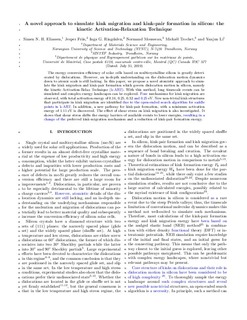| dc.contributor.author | Eliassen, Simen Nut Hansen | |
| dc.contributor.author | Friis, Jesper | |
| dc.contributor.author | Ringdalen, Inga Gudem | |
| dc.contributor.author | Mousseau, Normand | |
| dc.contributor.author | Trochet, Mickaël | |
| dc.contributor.author | Li, Yanjun | |
| dc.date.accessioned | 2020-03-16T10:12:55Z | |
| dc.date.available | 2020-03-16T10:12:55Z | |
| dc.date.created | 2019-11-27T17:32:52Z | |
| dc.date.issued | 2019 | |
| dc.identifier.citation | Physical review B (PRB). 2019, 100 (15), . | nb_NO |
| dc.identifier.issn | 2469-9950 | |
| dc.identifier.uri | http://hdl.handle.net/11250/2646907 | |
| dc.description.abstract | The energy conversion efficiency of solar cells based on multicrystalline silicon is greatly deteriorated by dislocations. However, an in-depth understanding on the dislocation motion dynamics down to atomic scale is still lacking. In this paper, we propose a novel atomistic approach to simulate the kink migration and kink-pair formation which govern dislocation motion in silicon, namely the kinetic activation-relax technique (k-ART). With this method, long timescale events can be simulated and complex energy landscapes can be explored. Four mechanisms for kink migration are observed, with total activation energy of 0.16, 0.25, 0.32, and 0.25 eV. New nontrivial kink structures that participate in kink migration are identified due to the open-ended search algorithm for saddle points in k-ART. In addition, a new pathway for kink-pair formation, with a minimum activation energy of 1.11 eV is discovered. The effect of shear stress on kink migration is also investigated. It shows that shear stress shifts the energy barriers of available events to lower energies, resulting in a change of the preferred kink-migration mechanism and a reduction of kink-pair formation energy | nb_NO |
| dc.language.iso | eng | nb_NO |
| dc.publisher | American Physical Society | nb_NO |
| dc.title | Atomistic approach to simulate kink migration and kink-pair formation in silicon: The kinetic activation-relaxation technique | nb_NO |
| dc.type | Journal article | nb_NO |
| dc.type | Peer reviewed | nb_NO |
| dc.description.version | acceptedVersion | nb_NO |
| dc.source.pagenumber | 11 | nb_NO |
| dc.source.volume | 100 | nb_NO |
| dc.source.journal | Physical review B (PRB) | nb_NO |
| dc.source.issue | 15 | nb_NO |
| dc.identifier.doi | 10.1103/PhysRevB.100.155305 | |
| dc.identifier.cristin | 1753368 | |
| dc.relation.project | Norges forskningsråd: 255326 | nb_NO |
| dc.relation.project | Norges forskningsråd: nn9158k | nb_NO |
| dc.description.localcode | © American Physical Society 2019. This is the authors accepted and refereed manuscript to the article. | nb_NO |
| cristin.unitcode | 194,66,35,0 | |
| cristin.unitname | Institutt for materialteknologi | |
| cristin.ispublished | true | |
| cristin.fulltext | postprint | |
| cristin.qualitycode | 2 | |
